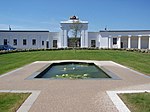Explosion Museum of Naval Firepower

The Explosion Museum of Naval Firepower is situated in the former Royal Naval Armaments Depot at Priddy's Hard, in Gosport, Hampshire, England. It now forms part of the National Museum of the Royal Navy.The museum includes a wide variety of exhibits ranging from the 18th century to the present day. These range in size from small arms, to missiles and missile launching systems, as well as complete gun turrets. Exhibits range from the Victorian RBL 20 pounder Armstrong gun through to the Second World War QF 4 inch Mk XVI naval gun. Post-war missile systems include the Exocet missile and launcher and Sea Dart missile. Modern weapons are represented in the Sea Wolf missile system and 4.5 inch Mark 8 naval gun. The weapons cover all aspects of naval warfare from surface to surface, air to surface, surface to air and sub-surface weapons systems, including mines and torpedoes. The museum has a waterside coffee shop which looks out on to the original 18th-century camber dock.
Excerpt from the Wikipedia article Explosion Museum of Naval Firepower (License: CC BY-SA 3.0, Authors, Images).Explosion Museum of Naval Firepower
Heritage Way,
Geographical coordinates (GPS) Address External links Nearby Places Show on map
Geographical coordinates (GPS)
| Latitude | Longitude |
|---|---|
| N 50.8075 ° | E -1.1261 ° |
Address
Explosion! Museum of Naval Firepower
Heritage Way
PO12 4WF , Priddy's Hard
England, United Kingdom
Open on Google Maps











